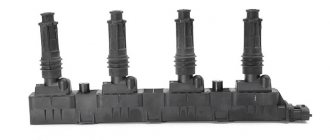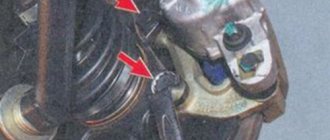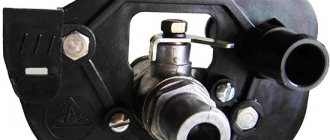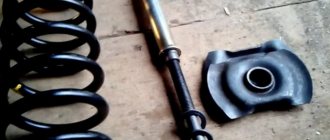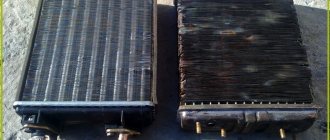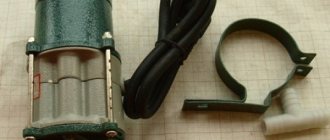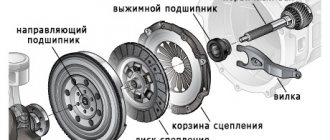The interior heating system of the VAZ 2107 is durable and reliable. But, like any other node, it can fail. Such breakdowns include a malfunction of the heater radiator. This is expressed by a leak of coolant from the radiator, clogging of the channels, which prevents the normal circulation of antifreeze through the heater radiator. These problems can occur on cars with any engine, be it a carburetor or an injector.
We will look at the signs of a breakdown of the VAZ 2107 heater radiator and the method of replacing it.
Signs of a malfunction of the VAZ 2107 heater radiator
A malfunction of the heater radiator can be due to two reasons:
- Coolant leakage from the radiator.
- Clogged internal channels.
It is necessary to remove the radiator of the VAZ 2107 cooling system; if any of these problems are detected, after dismantling it is repaired or replaced with a new one. The replacement process itself is not very complicated; you need to be careful and careful. To replace the heater radiator you will need the following tools:
- Key to 7;
- Key for 10;
- Crosshead screwdriver;
- Rags;
- Coolant;
- two new rubber gaskets.
Dismantling algorithm
VAZ cars of the classic family, which includes modification 2107, are good because to remove the heater radiator you do not need to dismantle the front panel, so the work of removing the heat exchanger of the interior heating system is not difficult. No specific tools are required, just 8 and 10 size screwdrivers and wrenches are needed.
Algorithm for removing the heater radiator:
- Drain the coolant by unscrewing the drain plugs on the engine and main radiator.
- On the left side of the engine shield (standing in front of the car) we look for two rubber tubes through which coolant is supplied and discharged to the heater. We loosen the clamps of these tubes and tighten them.
- We unscrew the screws securing the rubber seal through which the metal radiator pipes pass. Let's remove the seal.
- We move to the salon.
- We dismantle the shelf under the storage compartment on the passenger side. To do this, you need to unscrew the screws that secure it.
- Remove the lower part of the center console. It is attached to the floor and front panel with self-tapping screws. Since keys, a cigarette lighter, and a clock are installed on the lower part, after unscrewing the fastening elements, we move the box toward you (by turning on the reverse gear at the gearbox) and disconnect the wiring going to the indicated elements (it is better to mark the wires so as not to confuse them during assembly). After this, the box can be removed from the cabin.
- Unscrew the control mechanism cable from the antifreeze supply shut-off valve.
- We disconnect the lower part in which the fan is located from the stove body. It is attached to the top of the case using 4 latches installed on the sides. Use a screwdriver to pry up the latches, after which the lower part of the case will drop down. We move it to the side or completely remove it, having first disconnected the power wires of the fan motor.
- After dismantling the bottom of the case, you will have access to the radiator, which can be removed by pulling it down using the metal pipes.
Radiator installation
We recommend: Torque converter repair - if the automatic transmission breaks down
Note that this is only one of the methods for disassembling the stove on a VAZ-2107. It is not necessary to drain the antifreeze; you can disconnect the rubber tubes without removing them, and 1.0-1.5 liters of coolant will flow out of the cooling system, which are topped up after assembly. The main thing is that after disconnecting the tubes, lift their ends up and secure them in this position.
During the disassembly process, you can immediately disconnect the pipelines from the radiator along with the shut-off valve and then remove the heat exchanger itself.
Removing the heater radiator
The first step is to remove the fan housing. To do this, you need to remove the bottom of the glove compartment and the lower shelf, the radio panel, disconnect the electrical wiring connections and you will have access to the heater fan housing.
After removing it, you will have access to the heater radiator. It is advisable to place a rag or some kind of rag on the floor, since coolant may leak during replacement.
Next, the work continues under the hood of the VAZ 2107. It is necessary to remove the rubber pipes from the heater valve pipe and the outlet pipe. We release the clamps with a Phillips screwdriver and tighten the pipes.
Next, use a 7mm wrench to unscrew the two bolts and remove the sealing gasket through which the heater tubes come out.
We return back to the interior of the VAZ 2107 car and disconnect the heater tap control cable. There is nothing else that prevents the removal of the radiator; we remove the tubes from the partition between the engine compartment and the passenger compartment, and carefully remove it.
Next, using a 10mm wrench, unscrew the four bolts that hold the heater valve and the outlet pipe.
We carry out repairs, replace the heater valve and gaskets, flush the radiator; if it is unsuitable for further use, then buy a new one.
How to replace the heater radiator on a VAZ 2107 with your own hands
There are many malfunctions of the VAZ 2107 car that cannot be detected immediately. As a rule, they do not have a direct effect on the operation of the main units, and are detected after some time. Such malfunctions also include a malfunction of the heater radiator. It can be expressed in the formation of a coolant leak from the radiator, clogging of internal channels, preventing its normal circulation through the heater radiator. All cars are susceptible to such problems, with any type of engine, be it an injector or a carburetor.
Any of these malfunctions of the VAZ 2107 cooling system requires removal of the radiator, after which it is repaired or replaced with a new one. The replacement itself is not too difficult, but requires some care and precision. To complete the work you will need the following tools:
- Key for 10;
- Key to 7;
- Crosshead screwdriver;
- Rags.
In addition, you need to stock up on coolant for topping up after replacement and two new rubber gaskets.
First of all, you need to remove the fan housing. To do this, you need to remove the shelf and the bottom of the glove box, the radio panel, and disconnect the electrical wiring connecting blocks. This allows access directly to the heater fan housing. By removing it, you will have access to the heater radiator. It is recommended to place a rag on the floor, since replacing it may cause fluid to leak from the cooling system.
Let's move on to the engine compartment of the VAZ 2107. It is necessary to remove the rubber pipes from the outlet pipe and the heater tap tube. To do this, use a Phillips screwdriver to release the clamps holding the pipes together.
Then use a 7mm wrench to tighten the two screws and remove the sealing diaphragm through which the heater tubes are routed.
We return to the VAZ 2107 interior and unscrew the casing of the heater valve control cable, remove the loop from the lever. There is nothing holding the radiator anymore, and by carefully removing the tubes from the partition between the passenger compartment and the engine compartment, you can carefully remove it.
Next, using a 10mm wrench, we sequentially unscrew the four bolts holding the outlet pipe and the heater valve.
If this is possible, repair or flush the radiator, otherwise buy a new one. Take this opportunity to check the condition of the heater tap and, if necessary, replace it. Assembly and installation occurs in the reverse order:
- Sequentially screw the tap and outlet pipe onto the radiator using a 10mm wrench. In this case, replace the old rubber gaskets with new ones. Don't forget to change them, because old gaskets can cause leaks in the future.
- Carefully install the radiator in its original place, inserting the tubes into the partition.
- Place the diaphragm on the tubes and secure it with two self-tapping screws using a size 7 wrench.
- It is necessary to put rubber pipes of the cooling system on the tubes and tighten the worm clamps. If the old clamps do not provide high-quality fixation of the pipes, they also need to be changed.
- All that remains is to secure the heater tap control cable in place and adjust it so that the control lever fully opens and closes the tap.
All operations directly related to replacing the VAZ 2107 heater radiator and restoring the functionality of the cooling system have been completed. However, before proceeding with final assembly, it is recommended to check all connections and the stove itself for coolant leaks. To do this, you need to open the heater tap and start the engine. Thus, we will ensure the circulation of liquid through the heater radiator and at the same time remove air pockets. Now you can add the missing volume of liquid to the cooling system and you can proceed to final assembly.
All that remains is to sequentially install the heater fan housing, radio panel, glove box housing and shelf into place. Do not forget to connect the electrical wiring terminals, otherwise you will have to disassemble everything and reassemble it again. As you can see, replacing the VAZ 2107 heater radiator does not cause any difficulties.
Installing a stove radiator
Installing the radiator is done in the reverse order. To prevent future coolant leaks, it is better to replace the radiator clamps and pipes with new ones. This especially applies to pipes.
Open the heater valve before adding coolant. After adding antifreeze, you need to start the engine and let it run a little at high speeds. The circulation of coolant from the pump will expel any air pockets that could have formed when filling it. After all this, we check the antifreeze level and if it is low, then add it to the radiator and expansion tank to the mark.
Preparing the car for unit replacement
Prepare - this means draining all or part of the coolant from the cooling system. Otherwise, when disconnecting the stove pipes, liquid will spill.
A warm engine is optimal for draining fluid from the system. To make it easier to get to the drain hole, it is better to use an inspection hole or overpass. First remove the radiator cap and open the expansion tank.
Located at the hood, on the driver's side, we find the coolant drain plug. It is located below the fourth and last cylinder near the plug. It's difficult to confuse it with something else. We substitute the prepared liquid pan and unscrew the bolt.
You will have to wait three minutes, this time will be enough to free the system. Screw the bolt into place. Even if all the liquid did not come out, its level dropped below the level of the stove radiator. We can assume that the procedure for preparing the car for replacing the radiator heater is over. Do not forget to screw the plug into place, now you can remove the unit.
Heater stove VAZ 2107, principle of operation
The heating system operates as follows:
Air enters the air intake box, which is located in the engine compartment near the windshield, through special grilles on the hood.
In the event of a downpour or rain, water, separated from the air, flows into the holes in the box. This makes it possible to use the heater in any weather, but until the radiator heats up, the air entering the cabin during rain will be damp.
The air flow rushes into the heater and, passing through the radiator, heats up. Heating is regulated using a tap that regulates the amount of coolant passing through. The crane is controlled by a flexible rod, which is attached to the control lever.
When driving, the air flow enters under the hood and the air independently enters the heater. When stopping or driving at low speeds, an electric fan is used, which is controlled by a switch with three positions: “low speed”, “full speed” and “off”. Reduced speed is achieved by turning on the electric motor through a resistor, which reduces the voltage on the motor winding.
After the radiator, the air enters the air ducts and exits through deflectors, which allow you to change the direction of flow.
How to replace a fan with a more powerful one (in detail)
Work order:
- Remove the lower part of the stove - the casing on which a regular fan is mounted.
- Remove the standard electric fan completely as it will no longer be needed.
- Carefully cut off one of the aerodynamic ridges that supply air to the legs of the passenger and driver, since the motor from the V8 is much longer.
- Next, the impeller is removed, and all functions fall on a standard five-bladed fan.
- The hole in the impeller needs to be slightly enlarged in diameter and the new shaft carefully inserted into it. Make sure that the new structure fits securely into place.
- Before installing a new fan, connect it directly and check its functionality.
- Replace the built-in resistor, the main task of which is to ensure relatively quiet operation of the fan. As a result of the large volume of air being transferred, the new fan will create a lot of noise. The best replacement option would be a resistor installed on the figure eight.
- Replace the fan switch with a similar one from model 2108. The reason is that when the heater operates for a long time, a completely different current will be supplied, which is why after some time the standard power button will simply melt.
Design
The design of the VAZ 2105 and 2107 stoves is absolutely the same. And they consist of the following elements:
- Radiator;
- faucet;
- Holes for airflow of legs and interior;
- Stove motor;
- Radiator pipes;
- Gaskets;
- Protective cover.
In case of any breakdown associated with this mechanism, you will definitely have to remove the heater radiator. Since the cause of the breakdown mainly lies in it, for example, a coolant leak, clogged pipes, etc. But sometimes it’s not enough to just clean a part; sometimes you have to replace it. Let's look at how to do this now.
The device of the heater stove VAZ 2107
Like any component in a car, the stove can also stop functioning. In winter, such a breakdown can make the car impossible to operate: the windows become covered with frost or sweat, resulting in poor visibility.
To repair the stove yourself, you need to know its structure.
The heating system includes the following components:
- Heater. Its task is to heat the air. The main element of the heater is the radiator, through which coolant circulates.
- A fan that directs heated air into the cabin. The fan is mounted in the casing using elastic pads that dampen vibration.
- The stove control system, which includes a fan button, as well as dampers and control knobs for heating modes.
Causes and signs of heating fan failure
The list of reasons why a VAZ 2107 stove fan may break is small. Here he is:
- breakage of the blade in the impeller. As mentioned above, the furnace fan impeller on the VAZ 2107 is unreliable because it is made of very fragile plastic. To make matters worse, the fragility of this material increases in the cold. Therefore, you should not be surprised that the impeller breaks in the most severe frost;
- motor failure. The impeller is mounted on a small rod, and it, in turn, is built into the electric motor. Like any other unit, the electric motor can fail. This usually happens due to sudden voltage surges in the vehicle's on-board network. This can also happen due to the fact that the motor has simply exhausted its service life (usually its brushes that remove the charge from the rotor windings fail).
The signs by which you can recognize a breakdown of a heating fan are also well known. Let's list them:
- After turning on the heater the fan does not make noise. This means that either the motor is broken, or it is working properly, but the current supply to it is interrupted. This usually occurs due to a blown fuse responsible for this section of the vehicle’s on-board electrical network;
- The rotation of the heating fan is accompanied by a loud grinding or crackling noise. This means that a piece of the blade has broken off from the impeller and is hitting the inside of the furnace casing;
- The furnace fan rotates with a loud, continuous squeaking noise that gets louder as the speed increases. The source of the squeak is the bushing in the fan. Over time, it wears out, and play appears on the fan, which causes a characteristic creaking sound.
About lubrication of the heating fan VAZ 2107
In short, lubricating the fan on a VAZ 2107 is a pointless task. Now more details. All heating fans on the VAZ 2107, regardless of the year of manufacture of the car, are equipped only with bushing bearings. As mentioned above, the bushing wears out over time and begins to creak piercingly. If the play resulting from wear of the bushing is small, then the creaking can be eliminated with the help of lubricant. But this is only a temporary measure that will lead to nothing, because very soon the lubricant will run out, the play will increase, and the fan will creak again. Therefore, the only rational option in this situation is to replace the furnace fan with a new one. Moreover, it is desirable that the new fan be equipped not with a bushing, but with a ball bearing, which will last twice as long.
By the way, about fans with ball bearings. Lately it has become extremely difficult to find them on sale. It is difficult to say what causes this. Perhaps this is due to the venerable age of the machine itself, which was discontinued a long time ago. So car owners, in search of the necessary spare parts, increasingly have to resort to a wide variety of tricks. For example, one driver I know thought of ordering a stove fan... on Aliexpress! When I heard about it, I didn't believe it. In response, the man took out his smartphone and showed me auction lots with fans. Where the VAZ fans came from at the Chinese online auction is a big mystery. But the fact remains a fact. By the way, they cost only a third more than domestic ones. This is likely an additional charge for delivery (even though the website proudly states that delivery is free). The parcel takes an average of one and a half months to reach our country.




